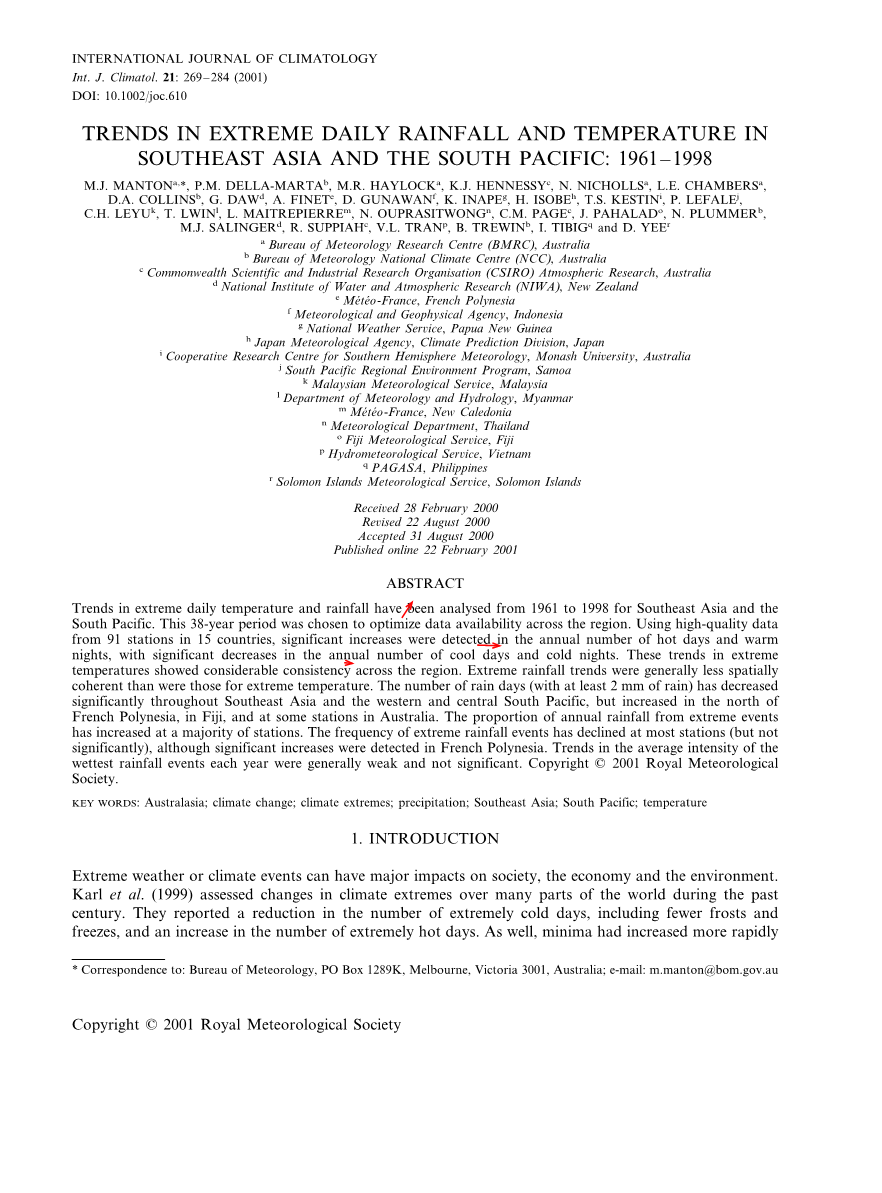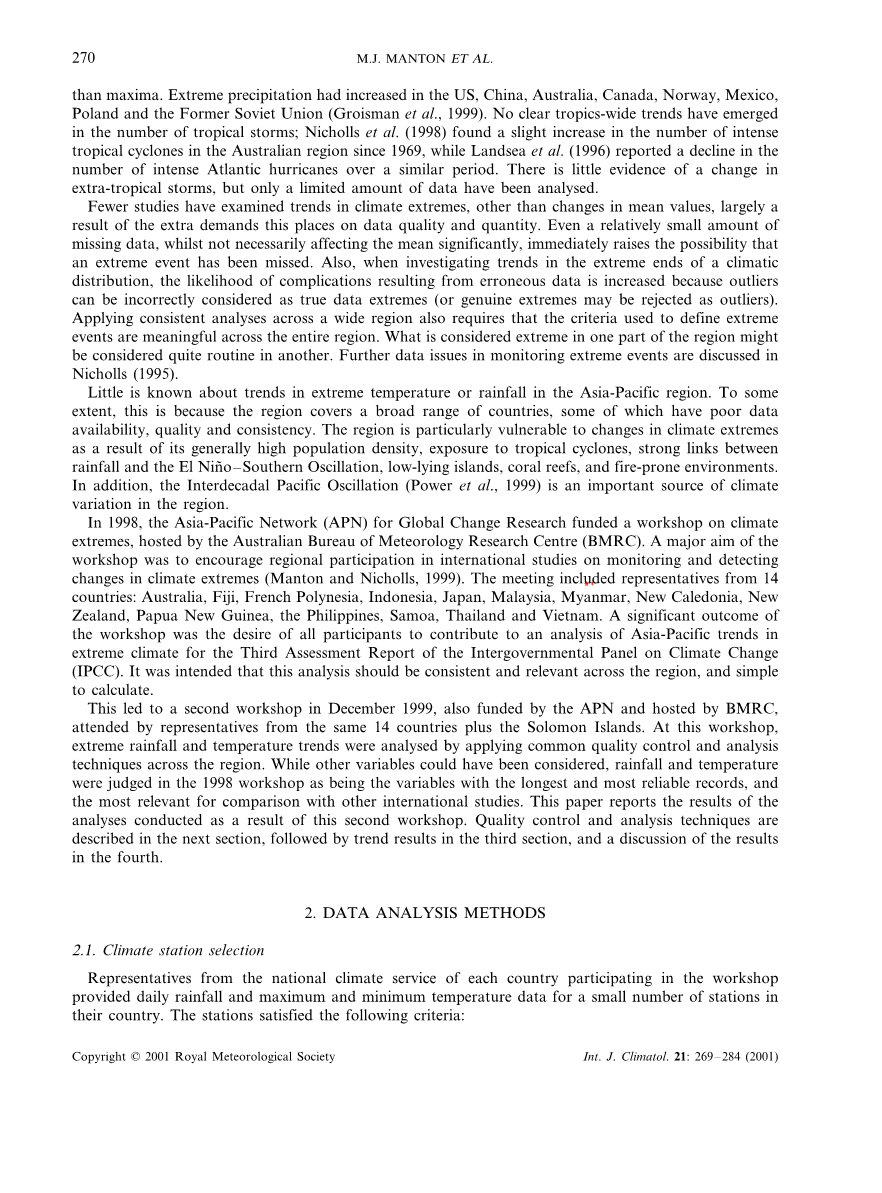

英语原文共 16 页,剩余内容已隐藏,支付完成后下载完整资料
1961-1998年东南亚和南太平洋地区极端降水和温度趋势
M.J. MANTONa,*, P.M. DELLA-MARTAb, M.R. HAYLOCKa, K.J. HENNESSYc, N. NICHOLLSa,
L.E. CHAMBERSa,D.A. COLLINSb, G. DAWd, A. FINETe, D. GUNAWANf, K. INAPEg, H. ISOBEh,
L.T.S. KESTINi, P. LEFALEj,C.H. LEYUk, T. LWINl, L. MAITREPIERREm, N. OUPRASITWONGn,
C.M. PAGEc, J. PAHALADo, N. PLUMMERb,M.J. SALINGERd, R. SUPPIAHc, V.L. TRANp, B. TREWINb,
I. TIBIGq and D. YEEr
a Bureau of Meteorology Research Centre (BMRC), Australia
b Bureau of Meteorology National Climate Centre (NCC), Australia
c Commonwealth Scientific and Industrial Research Organisation (CSIRO) Atmospheric Research, Australia
d National Institute of Water and Atmospheric Research (NIWA), New Zealand
e Meacute;teacute;o-France, French Polynesia
f Meteorological and Geophysical Agency, Indonesia
g National Weather Service, Papua New Guinea
h Japan Meteorological Agency, Climate Prediction Division, Japan
i Cooperative Research Centre for Southern Hemisphere Meteorology, Monash University, Australia
j South Pacific Regional En6ironment Program, Samoa
k Malaysian Meteorological Service, Malaysia
l Department of Meteorology and Hydrology, Myanmar
m Meacute;teacute;o-France, New Caledonia
n Meteorological Department, Thailand
o Fiji Meteorological Service, Fiji
p Hydrometeorological Service, Vietnam
q PAGASA, Philippines
r Solomon Islands Meteorological Sevice, Solomon Islands
摘要
本文分析了1961-1998年东南亚和南太平洋地区极端温度和降水趋势。选择所研究区域38年数据进行可适用性优化。使用15个国家共91个站点高质量数据进行分析,发现暖日和暖夜平均日数显著增加,冷日和冷夜平均日数显著减少。极端温度趋势在所研究区域显示出相当大的一致性。极端降水趋势比极端温度趋势表现出更弱的空间相关性。东南亚和南太平洋中、西部雨日日数(降水量小于2mm)显著减少,但是在法国波利尼西亚北部、斐济和澳大利亚的一些站点呈增加趋势。大多数站点的极端事件中平均降水量所占比例增加。除在法国波利尼西亚有显著增加外,极端降水事件的频率在大多数站点减少(但是并不显著)。每年的最湿润降水事件的平均强度逐渐较少,并不显著。
关键词:澳大利亚;气候变化;极端气候;降水;东南亚;南太平洋;温度
TRENDS IN EXTREME DAILY RAINFALL AND TEMPERATURE IN SOUTHEAST ASIA AND THE SOUTH PACIFIC: 1961–1998
M.J. MANTONa,*, P.M. DELLA-MARTAb, M.R. HAYLOCKa, K.J. HENNESSYc, N. NICHOLLSa,
L.E. CHAMBERSa,D.A. COLLINSb, G. DAWd, A. FINETe, D. GUNAWANf, K. INAPEg, H. ISOBEh,
L.T.S. KESTINi, P. LEFALEj,C.H. LEYUk, T. LWINl, L. MAITREPIERREm, N. OUPRASITWONGn,
C.M. PAGEc, J. PAHALADo, N. PLUMMERb,M.J. SALINGERd, R. SUPPIAHc, V.L. TRANp, B. TREWINb,
I. TIBIGq and D. YEEr
a Bureau of Meteorology Research Centre (BMRC), Australia
b Bureau of Meteorology National Climate Centre (NCC), Australia
c Commonwealth Scientific and Industrial Research Organisation (CSIRO) Atmospheric Research, Australia
d National Institute of Water and Atmospheric Research (NIWA), New Zealand
e Meacute;teacute;o-France, French Polynesia
f Meteorological and Geophysical Agency, Indonesia
g National Weather Service, Papua New Guinea
h Japan Meteorological Agency, Climate Prediction Division, Japan
i Cooperative Research Centre for Southern Hemisphere Meteorology, Monash University, Australia
j South Pacific Regional En6ironment Program, Samoa
k Malaysian Meteorological Service, Malaysia
l Department of Meteorology and Hydrology, Myanmar
m Meacute;teacute;o-France, New Caledonia
n Meteorological Department, Thailand
o Fiji Meteorological Service, Fiji
p Hydrometeorological Service, Vietnam
q PAGASA, Philippines
r Solomon Islands Meteorological Sevice, Solomon Islands
Abstract:Trends in extreme daily temperature and rainfall have been analysed from 1961 to 1998 for Southeast Asia and the South Pacific. This 38-year period was chosen to optimize data availability across the region. Using high-quality data from 91 stations in 15 countries, significant increases were detected in the annual number of hot days and warm nights, with significant decreases in the annual number of cool days and cold nights. These trends in extreme temperatures showed considerable consistency across the region. Extreme rainfall trends were generally less spatially coherent than were those for extreme temperature. The number of rain days (with at least 2 mm of rain) has decreased significantly throughout Southeast Asia and the western and central South Pacific, but increased in the north of French Polynesia, in Fiji, and at some stations in Australia. The proportion of annual rainfall from extreme events has increased at a majority of stations. The frequency of extreme rainfall events has declined at most stations (but not significantly), although significant increases were detected in French Polynesia. Trends in the average intensity of the wettest rainfall events each year were generally weak and not significant.
Key words:Australasia; climate change; climate extremes; precipitation; Southeast Asia; South Pacific; temperature
1.引言
极端天气或极端气候事件对社会、经济和环境有重要影响。Karl等对上个世纪世界范围内许多地区的极端气候变化进行了评估[1]。他们指出极端冷日日数,包括少数的霜冻和结冰日数减少,极端暖日日数增加。同时,最小值比最大值增加得更为迅速。美国、中国、澳大利
剩余内容已隐藏,支付完成后下载完整资料
资料编号:[19001],资料为PDF文档或Word文档,PDF文档可免费转换为Word


